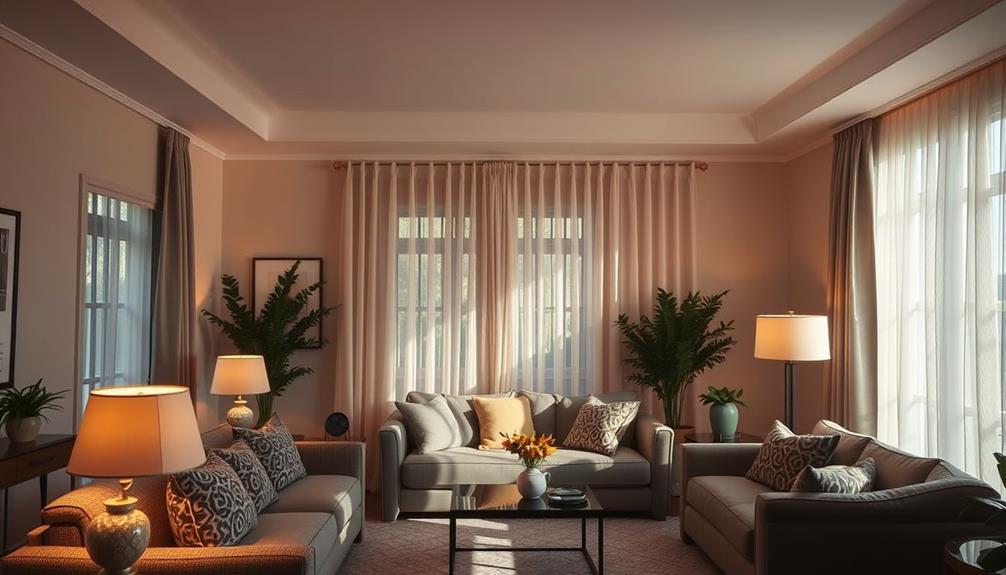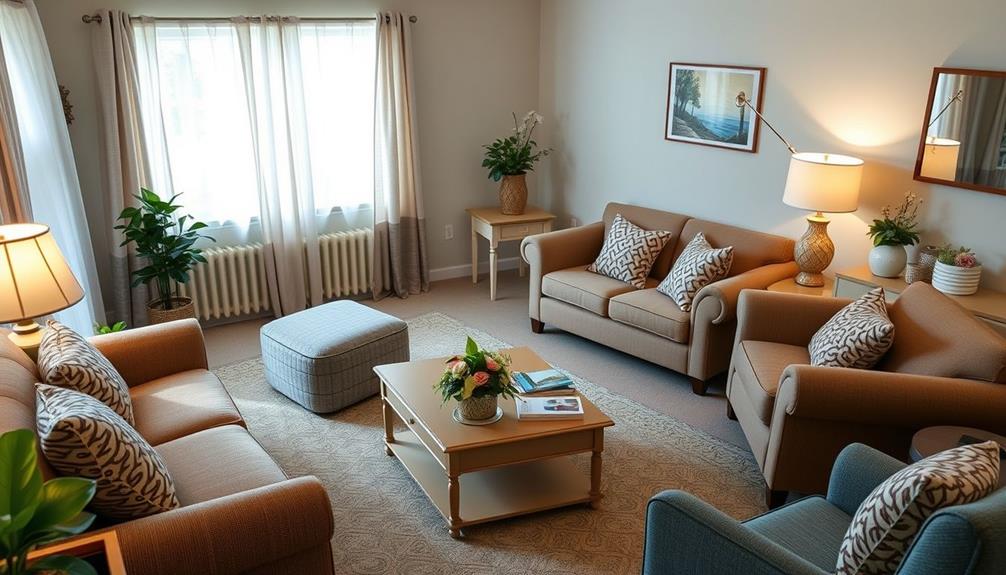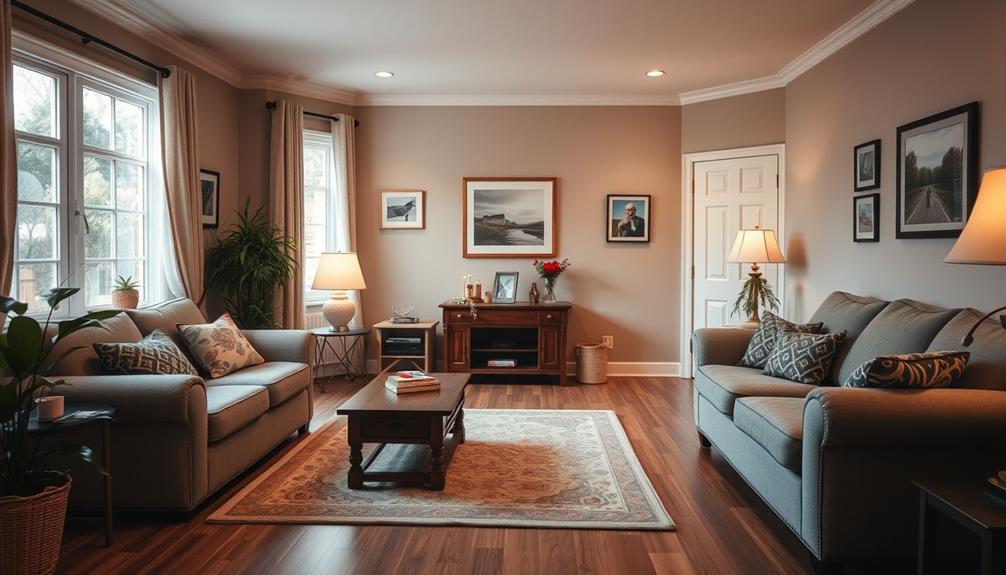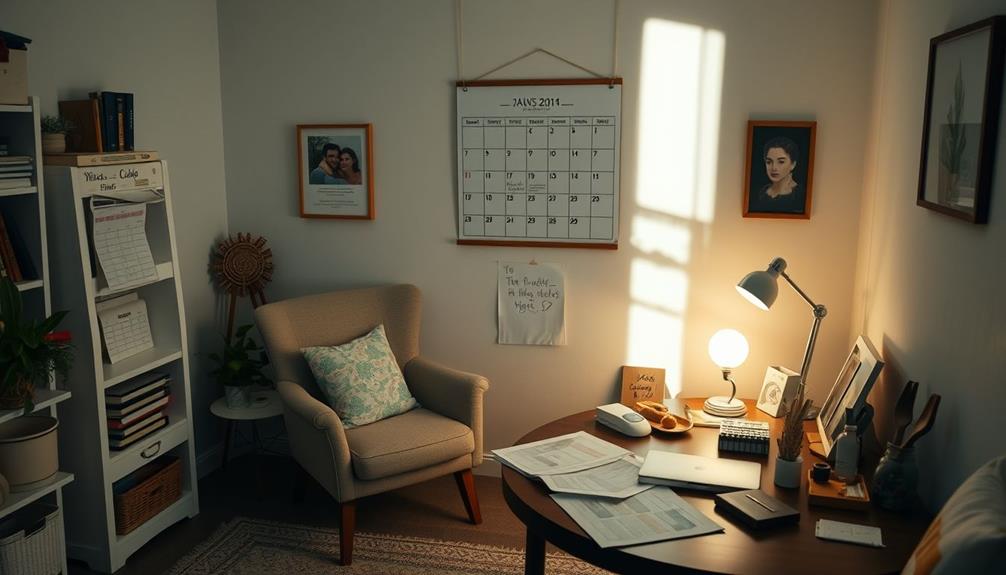Creating a home environment that is friendly for individuals with dementia begins with prioritizing safety and comfort. Installing grab rails and non-slip mats can help prevent falls, while using contrasting colors for visibility can make navigation easier. Bright, natural lighting can reduce confusion, and incorporating sound-absorbing materials can create a peaceful atmosphere. Keeping spaces clutter-free and organizing items with clear labels can enhance mobility, and designating quiet areas for relaxation can be beneficial. Including familiar elements in outdoor spaces can evoke positive memories. These thoughtful adjustments can make a significant difference in the quality of life for those with dementia. For more helpful advice and tips on making these changes, check out this insightful resource on creating meaningful activities for dementia care. Encouraging engagement in simple, familiar activities like gardening, drawing, or music can stimulate the mind and provide a sense of purpose. Tailoring these activities to the individual’s interests can further boost emotional well-being and overall quality of life. In addition to cognitive function maintenance, meaningful activities also promote emotional connections and a sense of accomplishment. It’s crucial to adapt activities to the individual’s current abilities to ensure they feel empowered rather than frustrated. Integrating regular physical movement, such as gentle exercises or walks, into activities for individuals with dementia at home can promote both mental and physical well-being.
Key Takeaways
- Prioritize safety by installing grab rails, non-slip mats, and removing tripping hazards throughout the home.
- Enhance visibility using contrasting colors for doorways, stairs, and furniture to aid navigation and recognition.
- Improve lighting with motion-sensor fixtures and dimmer switches, ensuring well-lit areas to reduce confusion and fall risks.
- Create a calm environment by minimizing background noise and incorporating sound-absorbing materials to ease anxiety.
- Organize spaces with easy-to-read labels and clutter-free arrangements, promoting independence and ease of movement for individuals with dementia.
Understanding Dementia Needs

Understanding the needs of someone with dementia is vital for creating a supportive home environment. Dementia impacts cognitive abilities, leading to challenges in memory, reasoning, and daily activities. To help manage these challenges, consider home modifications that prioritize safety and comfort. Incorporating elements from home security systems can enhance safety, as homes equipped with security measures are perceived as safer and can provide peace of mind for both the individual and their caregivers.
For instance, the presence of security systems can deter potential intruders, thereby creating a more secure living space.
Start by improving lighting throughout the home, as poor lighting can exacerbate confusion and disorientation. Opt for bright, even lighting to create a familiar environment. Additionally, reduce excessive noise and avoid complex visual patterns that may overwhelm them.
Familiarity with their surroundings can greatly reduce agitation, so maintaining a stable and recognizable layout is essential. You can also use assistive technologies, such as reminder systems or smart home devices, to help with memory loss and daily tasks.
Safety Modifications

Creating a safe environment is a vital aspect of supporting someone with dementia. Implementing effective safety modifications can greatly reduce the risk of accidents and enhance their overall well-being. Here are some essential steps you can take: Begin by ensuring that sharp objects, hazardous materials, and tripping hazards are removed or securely stored. Additionally, creating a safe home environment may involve installing grab bars in bathrooms, using non-slip mats, and placing clear signage to help with navigation. These measures can provide peace of mind and support for both the individual with dementia and their caregivers.
- Install grab rails in bathrooms and hallways to provide support and prevent falls. This aligns with understanding financial considerations for elderly care, guaranteeing that necessary modifications are within budget.
- Place non-slip mats in bathrooms and kitchens to minimize the chances of slipping on wet surfaces.
- Use contrasting colours for important areas, such as doorways and staircases, to improve visibility and help with navigation.
- Regularly check smoke detectors and carbon monoxide alarms to verify they're functioning properly; consider smart versions that alert caregivers to any issues.
Additionally, make certain to focus on removing tripping hazards like loose rugs, clutter, and unsecured cords.
These adjustments create a dementia-friendly home, promoting safety and comfort. By taking these proactive measures, you can create a living space that not only protects against accidents but also encourages independence and confidence for individuals living with dementia.
Enhancing Lighting

Proper lighting plays an essential role in making a home dementia-friendly. Good lighting can greatly reduce confusion and fall risk, especially in high-risk areas like stairs and bathrooms. To enhance visibility, maximize natural light by keeping curtains open and trimming plants that block sunlight.
You can also consider these effective home improvements:
| Lighting Solution | Benefits | Implementation |
|---|---|---|
| Motion-Sensor Lights | Automatic illumination, reduced fall risks | Install in dark areas |
| Dimmer Switches | Adjustable brightness for comfort | Use in living areas |
| Non-Reflective Fixtures | Minimized glare and shadows | Select matte lighting options |
Managing Noise Levels

Managing noise levels in your home can make a big difference for someone with dementia. By incorporating sound-absorbing materials like carpets and curtains, you can create a more peaceful environment.
Additionally, consider minimizing background noise from appliances and electronics, as a calmer atmosphere can help reduce confusion and agitation.
Regularly evaluating hearing can help guarantee that communication remains clear and effective, especially when addressing cold medications overview related to any discomfort.
Sound-Absorbing Materials
Often, incorporating sound-absorbing materials like carpets, cushions, and curtains can make a significant difference in a home for someone with dementia.
These materials can effectively reduce background noise, helping to create a calmer environment that enhances comfort. Additionally, engaging in sound therapy can further support emotional well-being, creating a soothing atmosphere conducive to relaxation and mindfulness, as explored in sound healing practices.
By using sound-absorbing materials strategically, you can foster a more peaceful atmosphere for dementia patients.
Here are four key benefits of using sound-absorbing materials:
- Minimized Distractions: Proper placement can help reduce visual and auditory distractions, allowing for better focus.
- Enhanced Comfort: A quieter home contributes to a more comfortable living environment, promoting relaxation.
- Reduced Confusion and Agitation: Lower noise levels can help alleviate confusion and agitation often experienced by dementia patients.
- Improved Sensory Experience: Creating a sound-friendly space can enhance overall sensory experiences, especially for those with dual sensory loss.
Limit Background Noise
Creating a serene atmosphere is crucial for individuals with dementia, and limiting background noise plays a key role in achieving that. A quiet environment enhances focus and comfort, making it easier for them to engage with their surroundings.
You can start by utilizing sound-absorbing materials like carpets, cushions, and curtains. These elements help absorb excess sound and create a quieter atmosphere, minimizing distractions and confusion. Additionally, incorporating regular health checks for signs of discomfort can help in identifying when noise levels might be affecting your loved one's well-being, as seen in signs of illness in pets.
Additionally, regularly turning off televisions or radios when they're not in use can greatly reduce auditory distractions. This is especially important for individuals experiencing dual sensory loss, as it helps to maintain a calm environment. By being mindful of the background noise in your home, you can help reduce agitation and anxiety, promoting a sense of well-being.
Consider creating designated quiet spaces where your loved one can retreat to when feeling overwhelmed. This simple change can contribute to a more peaceful living environment.
Fundamentally, by actively managing noise levels, you're not just creating a home; you're fostering a sanctuary that supports comfort and serenity for individuals with dementia.
Regular Hearing Assessments
Regular hearing assessments are essential for those with dementia, as they help pinpoint hearing loss that can worsen confusion and anxiety caused by background noise.
Understanding the interplay of key domains of development can provide insight into how sensory impairments affect cognitive functioning. It's important to remember that hearing loss is common in dementia patients, with nearly 60% of individuals with Alzheimer's experiencing significant impairment.
Regular check-ups can lead to timely interventions, enhancing communication and creating a better environment.
Here are four key benefits of regular hearing assessments:
- Identifies Hearing Loss: Early detection helps manage confusion and anxiety linked to impaired hearing.
- Improves Communication: Addressing hearing issues enables clearer interaction for both caregivers and individuals with dementia.
- Reduces Environmental Noise Impact: Proper aids can lessen the effects of background noise, fostering a calmer atmosphere.
- Supports Dual Sensory Loss: Understanding that individuals may struggle with both hearing and vision helps caregivers provide tailored assistance.
Choosing Safe Flooring

When designing a dementia-friendly home, choosing the right flooring is essential for safety and navigation. You'll want to prioritize safe flooring that minimizes confusion and reduces tripping hazards. Opt for non-reflective, matte surfaces to prevent disorienting reflections that can cause anxiety. Avoid rugs and loose mats, as they can increase fall risks, particularly for those with impaired balance.
To enhance visibility and stability, select flooring colors that contrast with wall colors. This contrast helps individuals with dementia navigate their environment more easily. Regularly check your flooring for wear or damage, confirming all surfaces are stable and hazard-free.
You can further enhance safety by installing non-slip mats in high-risk areas, such as bathrooms and kitchens, providing additional traction where it's needed most. Here's a quick reference table to guide you:
| Flooring Type | Benefits | Considerations |
|---|---|---|
| Non-reflective matte | Reduces confusion | Confirm it's durable |
| Non-slip mats | Provides traction | Only in high-risk areas |
| Contrasting colors | Improves visibility | Check for color preferences |
Utilizing Contrasting Colors

In a dementia-friendly home, utilizing contrasting colors can greatly improve visibility and navigation. By strategically applying bold colors, you enhance spatial awareness, which helps individuals with dementia identify their surroundings more easily. This approach aligns with the principles of Design Thinking, emphasizing user-centric solutions that cater to specific needs.
Here are some key areas where contrasting colors can make a significant difference:
- Walls and Floors: Choose solid colors that contrast sharply to enhance visibility and reduce confusion.
- Furniture: Opt for bold-colored furnishings that stand out against the walls and floors to aid recognition.
- Doors and Banisters: Highlight these features with contrasting colors to provide essential visual cues for safety, making it easier to locate points of entry and exit.
- Daily Tasks: Select toilet seats and crockery in contrasting colors to promote clarity and independence during daily tasks.
Remember to avoid bold patterns, as they may create disorientation. Solid colors are more favorable for furnishings and decor, ensuring a calm and clear environment.
Organizing Fixtures and Furnishings

To create a dementia-friendly home, organizing fixtures and furnishings plays an essential role in enhancing accessibility and safety. Start by making simple changes to your living space that help people navigate more easily. Use easy-to-read signs or symbols on cupboard doors and drawers, clearly indicating their contents. This way, familiar items are always easy to see and find.
Additionally, consider using a best soil mix for indoor plants, as incorporating greenery can create a calming atmosphere.
Avoid complex patterns on carpets and furnishings, as they can overwhelm and confuse individuals. Instead, opt for solid colors that help create a calm environment. Arrange furniture in a simple, clutter-free manner to promote safety and facilitate movement, minimizing the risk of trips and falls.
Consider installing D-shaped door handles in contrasting colors to make opening and closing doors easier. Guarantee that architraves and door frames are painted in colors that differ from the walls, enhancing visibility.
Bedroom and Kitchen Considerations

Creating a comforting and functional bedroom and kitchen environment is essential for individuals with dementia. By ensuring these spaces are designed thoughtfully, you can greatly enhance safety and emotional well-being. Here are some key considerations:
1. Bedroom: Maintain a clutter-free space and install motion-sensor lights to improve visibility at night. This helps individuals navigate safely.
Additionally, incorporating mindfulness practices can further support emotional stability and comfort during nighttime.
2. Contrasting Colors: Use plain bed covers with contrasting sheet colors to aid recognition, making it easier for them to identify their sleeping area.
3. Kitchen Organization: Group frequently used items together and use open shelving or clear labels. This promotes ease of access and encourages independence.
4. User-Friendly Appliances: Install refrigerators with large, contrasting handles to simplify usage, thereby reducing confusion and enhancing safety.
Creating designated areas for relaxation and activities in both the bedroom and kitchen can also foster engagement and support emotional well-being.
Outdoor Spaces and Gardens

Transforming outdoor spaces into dementia-friendly environments can greatly enhance the quality of life for individuals facing cognitive challenges. By incorporating familiar elements like colorful flowers and garden ornaments, you can evoke positive memories that encourage engagement.
Introducing unique planters, such as innovative planter designs, can add artistic flair while also being functional. Creating clear pathways with non-slip surfaces and contrasting colors guarantees safety and accessibility, reducing fall risks.
To promote comfort and relaxation, consider adding seating areas where individuals can rest and enjoy the beauty of nature. This also fosters social interaction with family and friends.
Raised garden beds are a fantastic option, allowing those with mobility challenges to participate in gardening activities without the strain of bending over.
Designing sensory gardens can offer a truly enriching experience. Use aromatic plants that stimulate the senses, along with textured surfaces that invite touch.
Colorful flowers not only brighten the space but also create a vibrant atmosphere that can uplift spirits. These elements work together to provide a calming, enjoyable outdoor experience, making your garden a welcoming haven for those with dementia.
Ultimately, these thoughtful modifications can transform outdoor spaces into nurturing environments that promote well-being and connection.
Frequently Asked Questions
What Are the Three Golden Rules of Dementia?
The three golden rules of dementia care focus on creating a supportive environment, effective communication, and respecting the individual's life history. Understanding these principles helps you provide compassionate and personalized care for those affected.
What Are Three Ways to Make a Home Dementia Friendly?
When it comes to making a home dementia-friendly, you can brighten spaces with natural light, declutter to simplify navigation, and use familiar items for comfort. These steps can really help create a supportive environment.
How to Design a Dementia Friendly Care Environment?
To design a dementia-friendly care environment, you'll want to guarantee good lighting, use contrasting colors for better visibility, and create a clutter-free space. Incorporate safety features to enhance accessibility and provide reassurance for everyone involved.
What Are the Four R's of Dementia Care?
Did you know that 1 in 10 people over 65 has dementia? The Four R's of dementia care are Recognize, Reassure, Respond, and Reinforce. Each plays an essential role in enhancing care and support.
Conclusion
Creating a dementia-friendly home is like crafting a safe harbor in a storm. Just as a lighthouse guides lost ships to shore, your modifications can help your loved one navigate their world with confidence. By understanding their needs and making thoughtful changes—like enhancing lighting and reducing noise—you provide clarity and comfort. Remember, each small adjustment contributes to a more familiar and welcoming space, allowing them to thrive in their own home, just as sailors find solace in calm waters.









